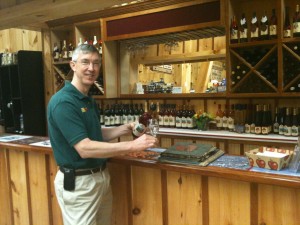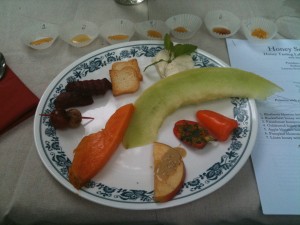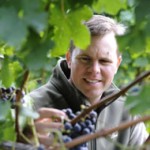Just ten days after the passage of a bill that will allow Connecticut farm wineries to sell their wines at farmer’s markets around the state, I caught up with one of the Connecticut winemakers instrumental in the creation of this bill, Keith Bishop. In addition to being a staunch advocate of our state’s wineries, this month’s Connecticut Corker is, himself, a winemaker, producing award-winning wines from apples, peaches, raspberries, pears, strawberries and blueberries, all grown on his farm at Bishop’s Orchards. Mr. Bishop’s most recent awards include medals for 13 of his wines entered into the 18th Annual Amenti del Vino International Wine Competition, including a Gold Medal for his Semi-Sweet Hard Cider and a much-coveted Double Gold Medal for Strawberry Delight.
 If there is one misconception that fruit winemaker, Keith Bishop, could correct, it is that not all fruit wines are overly sweet. “(Fruit wines) can be sweet, but they don’t have to be, and they definitely all aren’t.” Gone are the days of the early Boone’s Farm Apple Wine, which might be remembered by some baby boomers out there as that cloyingly sweet, mildly alcoholic fruit juice. Fruit wines can be just as elegant as grape wines and can be paired with an entire panoply of foods. When it comes to fruit wines, Mr. Bishop should know. It is the only kind of wine he makes and he is quite successful at it.
If there is one misconception that fruit winemaker, Keith Bishop, could correct, it is that not all fruit wines are overly sweet. “(Fruit wines) can be sweet, but they don’t have to be, and they definitely all aren’t.” Gone are the days of the early Boone’s Farm Apple Wine, which might be remembered by some baby boomers out there as that cloyingly sweet, mildly alcoholic fruit juice. Fruit wines can be just as elegant as grape wines and can be paired with an entire panoply of foods. When it comes to fruit wines, Mr. Bishop should know. It is the only kind of wine he makes and he is quite successful at it.
The Bishop family, one of the founding families of Guilford in 1639, began this farm in 1871 and six generations have worked the farm throughout the years. Bishop’s Orchards has grown from a roadside farm stand in 1910 to the bustling market it is today, selling, among other things, meat, dairy, baked goods, wine, and fruits and vegetables, many of which have been grown on their own 320 acres of farmland. Standing at the wine bar, the site chosen by Mr. Bishop for our interview, I was struck by both the history and charm of my surroundings. Our discussion was intermittently interrupted by customers in search of assistance, and I was impressed by the grace and good nature with which Mr. Bishop responded. This is a man who keeps his finger on the pulse of his business. At one point in our conversation, a woman carrying a couple of well-worn books approached us. She had discovered a dozen scrapbooks at a local tag sale that contained newspaper clippings of the Bishop family. She offered to temporarily leave all of the books with Keith for his enjoyment. Keith took a moment to browse through one of the books. He paused at a picture of his father taken after he won a national junior vegetable grower contest. The history here was indeed palpable. [Read more…]
 So what, exactly, do wine and honey have in common? More than you might think. Many people are familiar with mead, a centuries old honey wine often attributed with being the oldest alcoholic drink in the world. But last weekend, it was not wine that was being tasted. WINE attended a honey tasting laboratory at Red Bee in Weston. It was an eye-opening experience, to say the least.
So what, exactly, do wine and honey have in common? More than you might think. Many people are familiar with mead, a centuries old honey wine often attributed with being the oldest alcoholic drink in the world. But last weekend, it was not wine that was being tasted. WINE attended a honey tasting laboratory at Red Bee in Weston. It was an eye-opening experience, to say the least.